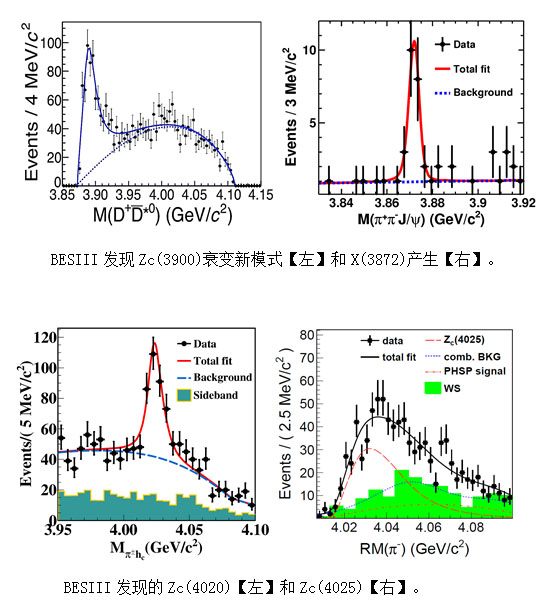Beijing spectrometer experiment finds new Zc structure
The Beijing Spectrometer III (BESIII) Experimental International Cooperation Group announced the discovery of a new resonance structure Zc (3900) in March 2013. This discovery has attracted widespread international attention. Journals of Physical Review Letters and Nature Report. Because it contains a pair of positive and negative quarks and has the same or opposite charge as the electrons, it is suggested that it contains at least four quarks, which is most likely the meson molecular state or the four quark state that scientists have long sought. The discovery of Zc (3900) triggered an upsurge of experimental and theoretical research, and led to a series of urgent questions: what kind of particle is Zc (3900), what is its spin-parity quantum number, and what else does it have In other decay modes, are there any accompanying states with the same nature as Zc (3900), etc.
After the announcement of the discovery of Zc (3900), the BESIII experiment quickly changed the data collection plan of the year, collecting 4 times the amount of data on the energy that may generate Zc (3900) or its concomitant state, thus having the largest in the world Data samples to study the properties of Zc (3900) and related particles are for in-depth study of the properties of Zc (3900), to find the adjoint states of Zc (3900) and to study other particles whose properties are not yet clear, such as X (3872) ) And Y (4260), etc. found by the BaBar experiment in the United States, provide the data basis.
In the four papers recently submitted, the BESIII cooperation group announced the discovery of a new decay mode of Zc (3900), and determined its spin-parity quantum number; two were found in two different decay end states A new resonant structure, named Zc (4020) and Zc (4025), respectively. They are most likely to be the companion states of higher quality of Zc (3900); the radiation transition of X (3872) in Y (4260) was first observed In the production. The above article has been submitted to Physical Review Letters for publication.
The newly discovered decay mode of Zc (3900) is that the final state contains a charged channel meson and a neutral vector anti-channel meson, and the experimental results show that this decay mode is better than the discovery of a charged p meson and a J / in Zc (3900). The ψ meson is much larger, about 6 times it, which can effectively distinguish the theoretical model about the nature of Zc (3900); using this decay model also determines that the spin of Zc (3900) is 1 and is called positive, this The information provides important inputs for theoretical model calculations and lattice specification quantum chromodynamic calculations.
Similar to the discovery of Zc (3900), Zc (4020) is also found in the final state containing a charged p particle and a chao Su particle, but the chao Su particle here is called hc, similar to J / ψ, it It is also composed of a pair of positive and negative charm quarks but with higher quality, so Zc (4020) and Zc (3900) have similar properties. Unlike Zc (3900), Zc (4025) is found in a completely different end state. The decay of Zc (4025) produces a neutral vector channel meson (contains a channel quark and an anti-upper quark) and a charged vector channel anti-channel meson (contains an anti-channel quark and a lower quark), so its components Contain at least 4 quarks.
The newly discovered Zc (4020) and Zc (4025) have very small mass differences, but there is a certain difference in the life of the decay. The current experimental data cannot yet determine whether the two are the same particle. Subsequent research is ongoing. Regardless of whether Zc (4020) and Zc (4025) are the same particle, they provide important experimental information for us to understand the properties of these new particles, especially in distinguishing these particles from the four-quark state or the molecular state. Is decisive.
The BESIII experiment also discovered for the first time a generation mode of X (3872), which is generated by the radiation transition of Y (4260). The particle discovered in 2003 has attracted extensive attention in theory and experiment due to its peculiar nature. However, due to the lack of experimental information, people are confused about its nature. The discovery of BESIII provides a possibility for accurate study of X (3872), but the current data volume of BESIII is still insufficient, and a larger data sample is needed for subsequent research.
The experimental results of BESIII link the current hot spots in the field of hadron spectra including X (3872), Y (4260) and Zc (3900), etc. It is very likely that these particles are inextricably linked. Prompt theoretical research should discuss them in a unified framework, so as to truly understand their nature.
At present, the data accumulated by the Beijing Spectrometer also provides many other possibilities for in-depth study of these charged stupodins. A number of physical analyses are being carried out intensively, combined with theoretical research in this field, will further reveal the strange state particles nature.

Silicone Kitchen Tools,Best Silicone Kitchen Tools,Cooking Silicone Kitchen Tools,Silicone Kitchen Tools Baking
Ningbo Honor Imp & Exp Co.,Ltd , https://www.honorhousehold.com